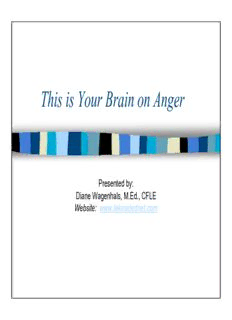
This is Your Brain on Anger PDF
Preview This is Your Brain on Anger
This is Your Brain on Anger Presented by: Diane Wagenhals, M.Ed., CFLE Website: www.lakesidednet.com Course Goals We expect to help participants: Consider how the brain responds to anger in biochemical ways that can in turn impact the course of one’s anger Explore ways the brain’s biochemical reactions set up physiological roadblocks Appreciate the fundamental ways the brain operates, grows and develops Understand and manage anger in healthy, effective ways Respond intentionally, systematically and effectively when others angrily confront them Course Goals We expect to help participants: Facilitate or teach others about anger Appreciate the impact of verbal aggressiveness and abuse Discover the effects of anger on child development Expand ways to use the NPTI Anger Tree to connect feelings with thoughts Background Information Scientists are in the process of discovering specific connections between emotions and physiological responses to those emotions. Emotions often have a social context: beliefs and behaviors that are accepted and expected by a culture greatly influence if, when and how a group of people feels and expresses anger. Anger is an emotional and physiological phenomenon. New research shows that emotionally expressing anger tends to exacerbate, not lessen, it. Brain Development The cortex is where logic and judgment reside; the thinking part of the brain. The cortex is located on the top area of the brain, with the pre-frontal cortex being the area right behind one’s forehead. The limbic system is the emotional part of the brain. The limbic system is located lower in the brain and is considered to be a more primitive area than the cortex. When someone is emotionally experiencing and expressing anger, they are not in the thinking part of the brain. Brain Development A small structure in the limbic system is the amygdala, which is “the sentry” of the brain. The amygdala is a storehouse for emotional memories. The amygdala is the area responsible for the “fight or flight” emotional reactions. The amygdala instantaneously checks in with the hippocampus and other parts of the brain responsible for storing memories. All incoming data from the world passes through the amygdala where decisions are made as to whether it goes to the cortex or limbic area. Brain Development If there is enough of an emotional charge created by incoming data, the amygdala can override the cortex. The person will now react from the lower brain area (limbic). When under extreme threat the person will react from the midbrain. The amygdala “charges into action without regard for the consequences” because it is not able to consider potential impact. Goleman (author of Emotional Intelligence) calls this an “amygdala hijacking.” Hormones of Anger The amygdala has the power to flood the brain with hormones called catecholamines that cause physical and emotional alarm. The first surge of hormones creates a rush of energy to prepare the person for fight or flight. The impact of this hormone can last several minutes. The thinking part of the brain may not be engaged when a person becomes violent in words or actions because of these hormones. Hormones of Anger It can take an average of 20 minutes for a person who has experienced an angry state of arousal to calm themselves, to move from the limbic to the cortex area. A second hormonal response is adrenocortical arousal whose impact can last for hours and even days. Having this hormone that lasts so long in the body can explain why someone has an initial, powerful anger reaction, seems to calm down, but then can have a huge flare-up later that is disproportionate to the situation. Dr. Bruce Perry “Any factors that increase the activity or reactivity of the brainstem (e.g. chronic, traumatic stress) or decrease the moderating capacity of the limbic or cortical areas (e.g. neglect, brain injury, mental retardation, Alzheimer’s, alcohol intoxication) will increase an individual’s aggression, impulsivity and capacity to be violent.”
Description: